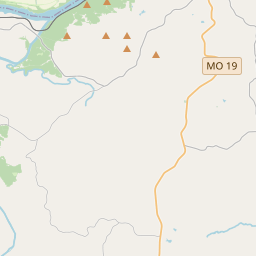The Lewis and Clark Expedition Across Missouri
Historical marker location:
New Haven, Missouri
( Marker is on Main Street west of Miller Street, on the left when traveling east.)







© OpenStreetMap contributors
A brief timeline of the Lewis and Clark Expedition
- 1803: President Thomas Jefferson commissions Meriwether Lewis, his personal secretary, to lead an expedition to explore the western territories of the United States and find a practical route to the Pacific Ocean.
- 1804: Lewis meets up with William Clark, a former army officer and experienced explorer, in Kentucky. They assemble a team of over 30 men and set out on the journey up the Missouri River.
- 1805: The expedition reaches the Rocky Mountains and crosses the Continental Divide. They build Fort Clatsop on the Pacific coast and spend the winter there, before returning east in the spring of 1806.
- 1806: Lewis and Clark split up to explore different routes on their way back to St. Louis. They reunite in September and return to civilization, where they are celebrated as national heroes.
- 1807: The Lewis and Clark Expedition publishes an official account of their journey, called the "History of the Expedition Under the Command of Captains Lewis and Clark," which becomes a bestseller and helps to promote westward expansion.
More history nearby
Missouri played a significant role in the Civil War, with battles such as the Battle of Wilson's Creek and the Battle of Pea Ridge taking place on its soil.
About Franklin County
Franklin County Timeline
Franklin County, Missouri boasts a rich and diverse history that spans over two centuries. Settlement in the area began in the late 18th century, with the arrival of French fur trappers and traders. These early pioneers were soon followed by German immigrants, who established farms and brought with them a strong agricultural tradition that continues to this day.
The county was officially created in 1818 and named in honor of Benjamin Franklin, one of America's Founding Fathers. Located along the picturesque banks of the Missouri River, Franklin County quickly became an important transportation hub, with riverboats playing a crucial role in the county's economic development. The arrival of the railroad in the late 19th century further solidified Franklin County's importance as a center of commerce and trade.
Like many areas in Missouri, Franklin County played a significant role in the American Civil War. The Battle of Boeuf River occurred in 1861, a skirmish that resulted in a Union victory and helped solidify control of the region. The county saw its fair share of skirmishes and struggles during the war, leaving a lasting impact on the local community.
In the years following the Civil War, Franklin County experienced rapid growth and development. The county's agricultural economy flourished, with the production of tobacco, livestock, and dairy products playing a pivotal role. The county also saw the emergence of mining as a vital industry, as rich iron deposits were discovered in the region. This led to the establishment of numerous iron and steel foundries, providing employment opportunities and contributing to the county's prosperity.
Today, Franklin County continues to thrive as a vibrant community. It embraces its historic roots, with many preserved buildings and landmarks reflecting its past. While the county has seen modernization and advancements, it remains deeply connected to its agricultural heritage and maintains its welcoming small-town charm.
The county was officially created in 1818 and named in honor of Benjamin Franklin, one of America's Founding Fathers. Located along the picturesque banks of the Missouri River, Franklin County quickly became an important transportation hub, with riverboats playing a crucial role in the county's economic development. The arrival of the railroad in the late 19th century further solidified Franklin County's importance as a center of commerce and trade.
Like many areas in Missouri, Franklin County played a significant role in the American Civil War. The Battle of Boeuf River occurred in 1861, a skirmish that resulted in a Union victory and helped solidify control of the region. The county saw its fair share of skirmishes and struggles during the war, leaving a lasting impact on the local community.
In the years following the Civil War, Franklin County experienced rapid growth and development. The county's agricultural economy flourished, with the production of tobacco, livestock, and dairy products playing a pivotal role. The county also saw the emergence of mining as a vital industry, as rich iron deposits were discovered in the region. This led to the establishment of numerous iron and steel foundries, providing employment opportunities and contributing to the county's prosperity.
Today, Franklin County continues to thrive as a vibrant community. It embraces its historic roots, with many preserved buildings and landmarks reflecting its past. While the county has seen modernization and advancements, it remains deeply connected to its agricultural heritage and maintains its welcoming small-town charm.
Franklin County Timeline
This timeline provides a condensed summary of the historical journey of Franklin County, Missouri.
- 1818: Franklin County is established as one of the original five counties in the Missouri Territory.
- 1827: The town of Union is founded as the county seat of Franklin County.
- 1835: Construction of the first railroad, the Pacific Railroad, begins in Franklin County.
- 1850: The population of Franklin County reaches over 11,000.
- 1861-1865: Franklin County residents actively participate in the American Civil War, with some supporting the Union and others supporting the Confederacy.
- 1875: The Washington Manufacturing Company is established, bringing industrialization to Franklin County.
- 1930s: The Great Depression causes economic hardship in Franklin County, with many residents struggling to find work.
- 1950s: Franklin County experiences a period of rapid growth and development, with new infrastructure and industries being established.
- 1982: The Great Flood of '82 devastates Franklin County, causing widespread damage and loss of life.
- 2000s: Franklin County becomes a popular tourist destination, known for its scenic beauty and historical sites.